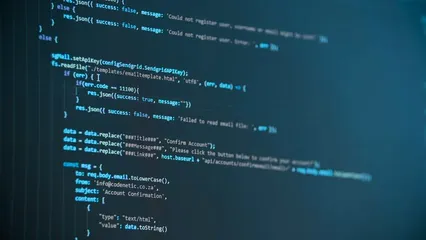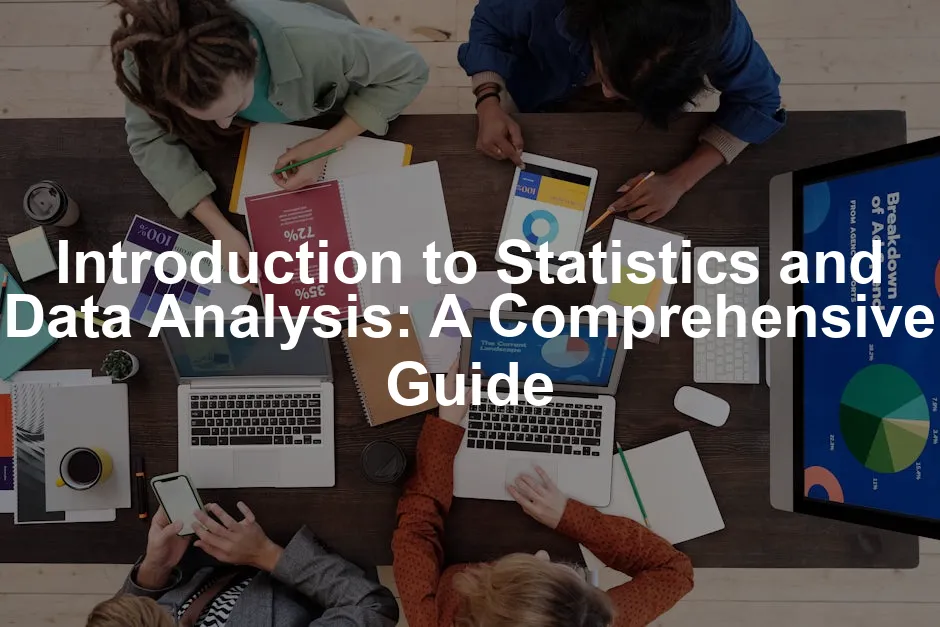Introduction
Statistics and data analysis – two terms that often make students and professionals alike break out into a sweat. But fear not! This article is your friendly guide through the tangled web of numbers, trends, and insights. Picture this: you’re at a party, and while everyone is talking about their weekend adventures, you’re quietly calculating the probabilities of their stories being true. Statistics isn’t just about crunching numbers; it’s about understanding the world around us.
What’s the deal with statistics, anyway? It’s like the backstage pass to our chaotic world. Whether it’s predicting weather patterns or analyzing social trends, statistics help us make sense of the noise. In this blog post, we will unravel the mysteries of statistics and data analysis and discuss why they are essential in today’s data-driven landscape. By the end, you’ll feel empowered to tackle statistics head-on, turning those intimidating figures into valuable insights.
Think of data analysis as your personal detective, uncovering hidden stories within piles of information. It’s not just for scientists or mathematicians. Everyone, from marketers to healthcare professionals, can benefit from statistical prowess. So, grab your calculator and let’s get started! You might even find yourself impressing your friends with your newfound ability to interpret data like a pro. Get ready to uncover the secrets behind the numbers, and let’s jump into the fascinating world of statistics and data analysis together.

Summary
In this article, we will explore the fundamentals of statistics and data analysis, starting from the basics and moving to more advanced concepts. You will learn about:
- Descriptive Statistics: Understanding how to summarize and describe data using measures of central tendency and variability.
- Probability Theory: A glimpse into the world of probability, including important concepts like random variables and probability distributions.
- Inductive Statistics: We will investigate hypothesis testing, confidence intervals, and regression analysis to make inferences about populations based on sample data.
- Data Visualization: Learn the importance of graphical representations in making data easier to understand and communicate.
- Applications in R: Discover how statistical software, particularly R, is used to perform data analysis and visualize results efficiently.
By the end of this article, you will have a solid foundation in statistics and data analysis, which will not only help you in academic pursuits but also enhance your decision-making skills in everyday life. You’ll be equipped to interpret data more critically, leading to better insights and conclusions. Whether you’re a student, a professional, or just someone curious about the numbers behind the news, this guide will serve as your go-to resource for understanding how statistics and data analysis work in practice.

Understanding Statistics and Data Analysis
What is Statistics?
Statistics is the science of collecting, analyzing, interpreting, and presenting data. It’s like the GPS of research, guiding us through the maze of information. Statistics is significant across various fields, including healthcare, business, and social sciences. In healthcare, it helps in understanding disease patterns and treatment effectiveness. In business, it drives decisions based on market trends and customer preferences.
There are two main types of statistics: descriptive and inferential. Descriptive statistics summarize data, providing insights into the main features. Think of it as the highlight reel of a sports game. It includes measures like mean, median, and mode, which give a snapshot of the data’s central tendency. Inferential statistics, on the other hand, allows us to make predictions or inferences about a larger population based on a sample. It’s like trying to guess the outcome of a game based on a few plays. For a deeper understanding of descriptive statistics, check out our descriptive statistics in manufacturing plant guide.
Understanding descriptive statistics is crucial for summarizing data effectively. Learn more about it here.
Real-life applications of statistics are everywhere. For instance, in politics, polls use statistical methods to predict election outcomes. In marketing, companies analyze consumer behavior to tailor their products. Even your favorite streaming service uses statistics to recommend shows you might like. By understanding statistics, we can make informed decisions that affect our lives daily.

Statistics provides the tools to extract meaningful insights from data. Whether you’re crunching numbers for a research paper or analyzing trends for a business strategy, mastering statistics unlocks a world of possibilities. To get started with your statistical journey, consider reading R Programming for Data Science by Hadley Wickham. This book is a great way to dive into the world of R and data analysis!
Key Concepts in Descriptive Statistics
Descriptive statistics are vital for summarizing and understanding data. The first key concept is measures of central tendency: mean, median, and mode. The mean is the average, calculated by adding all values and dividing by the number of observations. It’s commonly used, but sensitive to outliers. For instance, if you’re analyzing income data, a few high earners can skew the mean.
The median is the middle value when data is ordered. It’s more robust against outliers, making it ideal for skewed distributions. Think of it as the middle ground. The mode, the most frequently occurring value, is useful for understanding common trends. For example, if you’re surveying favorite ice cream flavors, the mode reveals the top choice. To further enhance your understanding, consider reading Naked Statistics: Stripping the Dread from the Data by Charles Wheelan, which presents these concepts with a humorous touch!
Next, we explore measures of dispersion: range, variance, and standard deviation. The range, simply the difference between the highest and lowest values, provides a quick glimpse of data spread. However, it doesn’t consider how data points are distributed. Variance measures how much the values differ from the mean, while standard deviation, the square root of variance, indicates how spread out the values are on average. A low standard deviation means values are close to the mean, while a high standard deviation indicates more variability.
Data visualization techniques enhance comprehension. Histograms display frequency distributions, revealing patterns at a glance. Box plots summarize data through quartiles, highlighting outliers. Scatter plots illustrate relationships between two numerical variables, showing correlations visually. Using these methods, we can transform complex data sets into digestible insights. To dive deeper into data visualization, consider checking out Data Visualization: A Practical Introduction by Kieran Healy.

Introduction to Probability Theory
Probability theory is the backbone of statistics, providing a framework for quantifying uncertainty. It begins with basic definitions: the likelihood of an event happening ranges from 0 (impossible) to 1 (certain). A simple example is flipping a coin. The probability of landing heads is 0.5, assuming a fair coin.
Probability distributions describe how probabilities are assigned to different outcomes. The normal distribution is the bell-shaped curve familiar to many. It’s essential in statistics because of the Central Limit Theorem, which states that the means of sufficiently large samples from any population will be normally distributed, regardless of the population’s distribution. To understand more about this theorem, refer to our discussion on the central limit theorem.
The Central Limit Theorem is crucial for understanding the behavior of sample means. Learn why it’s important here.
The binomial distribution models scenarios with two possible outcomes, like success or failure. It’s especially useful in quality control processes. For instance, if a factory produces light bulbs, the binomial distribution can help determine the probability of a certain number of defective bulbs in a sample. If you’re interested in a comprehensive introduction to these concepts, consider reading The Art of Statistics: Learning from Data by David Spiegelhalter.
The Poisson distribution describes the number of events occurring in a fixed interval, making it useful for modeling rare events. Think of it as the go-to distribution for counting occurrences, like the number of cars passing a checkpoint in an hour.
The Law of Large Numbers states that as the sample size increases, the sample mean gets closer to the population mean. This principle is critical for ensuring that our predictions become more accurate as we collect more data. When tackling data analysis, understanding these probability concepts is crucial for making informed decisions based on statistical evidence.

Inductive Statistics and Hypothesis Testing
Inductive statistics is a powerful tool in the realm of data analysis. It lets us make predictions and inferences about a larger population based on a smaller sample. But before we dive in, let’s clarify what we mean by populations and samples.
A population includes every member of a defined group. Think of it as the entire cast of your favorite TV show. In contrast, a sample is a subset of that population. You might only focus on a few key characters to analyze their development. The goal of inductive statistics is to use that smaller sample to draw conclusions about the entire population. It’s like trying to guess the ending of a series based on the first few episodes.
Next up: formulating hypotheses. Here, we break things down into two main types: the null hypothesis (H0) and the alternative hypothesis (H1). The null hypothesis is the status quo; it suggests there’s no effect or difference. The alternative hypothesis pushes against that notion, claiming there is an effect or difference. Imagine you’re betting on whether your favorite character will survive until the season finale. The null hypothesis says they won’t; the alternative says they will.
But what happens when we test these hypotheses? That’s where errors come into play.
We have Type I errors and Type II errors. A Type I error occurs when we reject the null hypothesis when it’s true. It’s like jumping to conclusions about a character’s fate when they’re actually safe—oops! On the flip side, a Type II error happens when we fail to reject the null hypothesis when it’s false. This is akin to ignoring a character’s imminent demise because you think they’re fine. Both scenarios can lead to significant misunderstandings in data interpretation.
Now, let’s outline the steps in hypothesis testing. First, you set up your hypotheses. Next, select a significance level (commonly 0.05). This level tells you how much risk you’re willing to take when rejecting the null hypothesis. After that, you collect your sample data and perform a test. Based on the results, you calculate the p-value.
The p-value indicates the probability of obtaining results at least as extreme as the ones observed, assuming the null hypothesis is true. If your p-value is less than the significance level, you reject the null hypothesis. If it’s greater, you fail to reject it. It’s like getting a spoiler alert: if the p-value is low enough, you know something significant is happening!
In summary, hypothesis testing is a structured approach to making inferences about populations based on sample data. By understanding populations, formulating hypotheses, and recognizing potential errors, you’re well on your way to mastering inductive statistics. So, the next time you’re analyzing data, remember: it’s not just about numbers; it’s about telling a compelling story with them!

Regression Analysis: An Overview
Regression analysis is an essential statistical tool that helps us understand relationships between variables. Imagine you’re trying to predict how much popcorn you’ll need for movie night based on the number of friends you invite. That’s regression in action!
Let’s start with linear regression. This method investigates the relationship between two continuous variables. It assumes that the relationship is linear, meaning it can be represented by a straight line. Picture it like a dance floor where the more friends you invite, the more popcorn you’ll need. The line of best fit will help you visualize this relationship.
However, there are some assumptions with linear regression. First, the relationship must be linear. Second, the residuals—those pesky differences between observed and predicted values—must be normally distributed. Lastly, the variance of residuals should remain constant across all levels of the independent variable. If these assumptions hold, linear regression can be a powerful predictive tool. For those wanting to delve deeper into regression techniques, check out Data Analysis Using Regression and Multilevel/Hierarchical Models by Gelman and Hill.
Now, let’s explore the relationship between variables further. Correlation measures the strength and direction of a relationship between two variables. A positive correlation means that as one variable increases, so does the other. Conversely, a negative correlation suggests that as one variable increases, the other decreases. So if your popcorn consumption and the number of friends invited have a strong positive correlation, you know you’re in for a fun movie night!
But what if your outcome variable is categorical? Enter logistic regression. This method is perfect for situations where the outcome is binary, like whether a movie is a hit or a flop. Logistic regression estimates the probability of a certain event occurring, making it a handy tool for marketers or producers trying to predict audience response.
In summary, regression analysis offers a variety of methods to explore and model relationships between variables. Whether you’re using linear regression for continuous data or logistic regression for categorical outcomes, understanding these concepts can help you make informed decisions based on data. So, next time you’re planning your movie night, let regression guide your popcorn strategy!

Data Analysis with R
R programming is a superstar in the statistics universe. It’s like the Swiss Army knife for data analysts, offering tools for everything from cleaning data to creating stunning visualizations. If you’ve ever felt overwhelmed by numbers, R is here to rescue you with its friendly syntax and powerful capabilities.
First off, why R? Well, it’s free and open-source, which means you can jump right in without breaking the bank. R is widely used in academia and industry, making it a valuable skill to add to your resume. Plus, it has a supportive community that’s always eager to help newcomers. Think of R as your data buddy, always ready to tackle the heavy lifting.
One of the delights of R is its extensive collection of packages. Packages are like special tools you can add to your R toolbox to enhance your data analysis. Some of the must-have packages include:
- dplyr: Perfect for data manipulation. It allows you to filter, sort, and summarize data without breaking a sweat.
- ggplot2: The go-to package for creating beautiful graphs. It transforms your data into eye-catching visuals that tell a story.
- tidyr: This one helps you tidy up your data. It makes sure your datasets are organized and easy to work with.
- readr: Say goodbye to tedious data import processes! This package allows you to load your data effortlessly from various formats.
Now, let’s get our hands dirty with some hands-on examples. Imagine you’re a data analyst for a pizza company. You’ve just received a dataset with customer orders, and you want to analyze the average order value. Here’s how you can do it in R.
First, you’ll need to load your dataset. Let’s say it’s in a CSV format. You can quickly import it using readr:
library(readr)
orders <- read_csv("pizza_orders.csv")Now that you have your data loaded, you can use dplyr to calculate the average order value. It’s as simple as:
library(dplyr)
average_order_value <- orders %>
summarize(AverageValue = mean(OrderValue, na.rm = TRUE))This code filters out any missing values and computes the average order value. Voilà! You’ve just extracted a meaningful statistic from your dataset.
Next up, let’s visualize the data with ggplot2. Suppose you want to see how orders vary by day of the week. Here’s how you can create a bar chart:
library(ggplot2)
ggplot(orders, aes(x = DayOfWeek, y = OrderValue)) +
geom_bar(stat = "summary", fun = "mean", fill = "skyblue") +
labs(title = "Average Order Value by Day of the Week",
x = "Day of the Week", y = "Average Order Value")This code produces a stunning bar chart that highlights trends in your data, making it easy to spot patterns. Maybe your customers love pizza on Fridays!
Lastly, let’s not forget about data cleaning. It’s the unsung hero of data analysis. R’s tidyr package makes cleaning your data a breeze. For instance, if your dataset has missing values, you can replace them with the mean or median values using:
orders <- orders %>
mutate(OrderValue = ifelse(is.na(OrderValue), mean(OrderValue, na.rm = TRUE), OrderValue))This code replaces any missing order values with the average, ensuring you have a complete dataset. For a comprehensive guide on mastering R, check out The Book of R: A First Course in Programming and Statistics by Timothy C. Keitt.
In summary, R programming is an invaluable tool for anyone looking to get serious about data analysis. Its key packages and functions enable you to manipulate, visualize, and clean data effortlessly. With just a few lines of code, you can extract powerful insights and tell compelling stories with your data. So, grab R and let your data adventures begin!

Conclusion
Statistics and data analysis are not just academic subjects; they are vital skills that allow us to make informed decisions based on data-driven insights. By understanding the core principles and methods discussed in this article, you can approach data with confidence. Whether you’re analyzing data for a project or interpreting statistical results in your field, the skills you’ve acquired will serve you well. Remember, every statistic tells a story; it’s up to you to interpret it and uncover the insights hidden within.
Statistics is the compass that guides us through the complexity of information. With the knowledge of R programming, you can harness the power of data analysis to support your arguments and decisions effectively. So, don’t shy away from numbers; embrace them! They can lead to revelations you never knew existed. If you want to delve deeper into the realm of statistics, consider picking up Statistics for Data Science by James D. Miller.
As you continue your journey in statistics and data analysis, keep practicing. The more you play with data, the more comfortable you’ll become. So, keep that curiosity alive, and let the data lead you wherever it may go. Happy analyzing!

FAQs
What is the difference between descriptive and inferential statistics?
Descriptive statistics summarize and describe data. They provide insights into features of a dataset, like averages or frequencies. Inferential statistics, however, make predictions or inferences about a larger population based on a smaller sample. Think of it as using a taste test to predict the flavor of an entire batch of ice cream!
How can I learn more about statistics and data analysis?
Learning statistics can be fun! Consider taking online courses. Websites like Coursera and edX offer fantastic options. You can also read textbooks, such as “Introduction to Statistics and Data Analysis” by Heumann et al. Additionally, practicing with statistical software like R can turn theory into practice. Hands-on experience is invaluable!
Why is R a popular choice for data analysis?
R is open-source and free! That’s a big win for students and professionals alike. It boasts a vast array of packages for statistical analysis and data visualization. Plus, it’s widely used in academia and industry. Whether you’re crunching numbers or creating eye-catching graphs, R has got your back!
What are some applications of statistics in everyday life?
Statistics are everywhere! In healthcare, they help track disease outbreaks. In finance, they guide investment decisions based on market trends. Marketers use statistics to understand customer behavior, tailoring products to meet their needs. Even social scientists rely on statistics to analyze societal trends. It’s all about making informed decisions based on data trends!
Please let us know what you think about our content by leaving a comment down below!
Thank you for reading till here 🙂
All images from Pexels




